Boston's Analog Shutdown: WHDH-TV, June 12, 2009
The day finally came. After three postponements, many millions
of dollars of equipment sales, nearly 68 years of commercial
analog television broadcasting in the United States finally came
to an end on June 12, 2009
Well, almost. Translators and other “Part 74”
television stations—including the increasingly numerous
“87.7 FM” channel-6 LPTVs operating primarily as radio
stations—still have a few years to go, and even full-power
stations could remain on the air for up to a month with a
repeating loop of DTV transition information and converter-box
installation instructions, provided their spectrum was not
immediately needed for something else.
In the Boston market, a slim majority of stations had already
signed off their analog signals for good, including channels 21,
25, 27, 44, 46, 48, 50, 58, 60, 62, and 68, plus all three New
Hampshire Public Television primaries. The Providence and
Springfield markets converted early, too, with Providence going on
the previously-scheduled date of February 17, and the few stations
in Springfield went one at a time over the past year. Shutting
down for good on June 12 were WHDH-TV (7 Boston, NBC), WLVI (56/41
Cambridge, CW), WSBK (38/39 Boston), WUTF (66/27 Marlborough,
Telefutura), and WMUR-TV (9 Manchester). In the case of WHDH and
WMUR, both stations activated their permanent digital signals on
the old analog channels (dumping transitional services on channels
42 and 59, respectively). Three more stations, WGBH-TV (2/19
Boston, PBS), WBZ-TV (4/30 Boston, CBS), and WCVB (5/20 Boston,
ABC), will continue on with “nightlight” service, WGBH
for two weeks and the other two stations for a month.
Thanks to transmitter guys Doug Kehrig and Brian Edgerton, and
WHDH/WLVI Director of Engineering Jim Shultis, I was able to watch
the shutoff of channels 7 and 56 from channel 7's transmitter
room. Channel 7 had the oldest Larcan TV transmitter still
operating in the United States, and it would be the last to get
shut down. Before that, at 11:56 p.m., Brian shut down the
channel 56 transmitter by remote control. Then, since authority
to operate transitional digital transmitters did not extend past
midnight, Brian shut down WHDH's digital channel 42 transmitter.
Finally, with less than a minute to go before midnight, Brian
walked over to the room with the old orange Larcan and pressed the
button that made the relays go “clunk!” and powered
off the old tube transmitter for good. Quickly operating a
remote-controlled feedline switch, he stepped over to the waiting
digital channel 7 and pressed a few buttons to power up the new
rig. The new Harris digital transmitter needs a paltry 3.7 kW to
make full power—only 29.7 kW average ERP—a far cry
from the more than 30 kW required to make 316 kW peak ERP for the
old analog signal.
(On June 16, WHDH received special temporary authority from the
FCC to turn the channel 42 transmitter back on, while the station
works to resolve reception issues with the new VHF service.)
 |
| WHDH-TV tower at night |
|
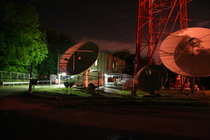 |
| WHDH-TV tx bldg |
|
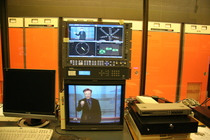 |
| Digital and analog monitors |
|
 |
| WLVI-TV shutdown |
|
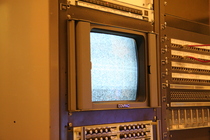 |
| Snow on channel 56 |
|
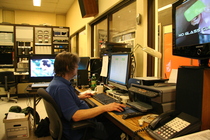 |
| WHDH-TV DT 42 shutdown |
|
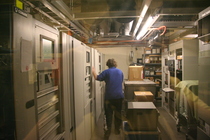 |
| WHDH-TV DT 42 transmitter |
|
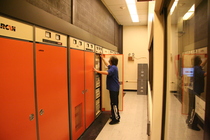 |
| WHDH-TV analog 7 shutdown |
|
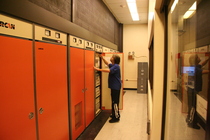 |
| WHDH-TV analog 7 shutdown |
|
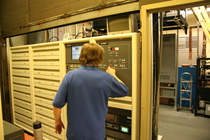 |
| WHDH-TV digital 7 startup |
|
 |
| WHDH-TV digital 7 on air |
|
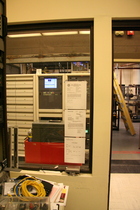 |
| Obligatory FCC documents |
|
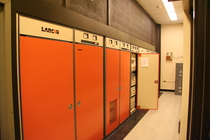 |
| Old Larcan |
|
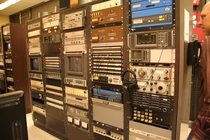 |
| Four racks of old analog gear |
|
Copyright 2009 Garrett Wollman. All rights reserved.













